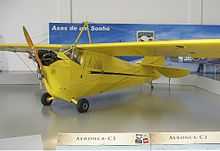Aeronca C-3
| C-3 | |
|---|---|
 | |
| Aeronca 100 at Sywell Airshow 2008 | |
| Role | Ultra-light monoplane |
| National origin | United States |
| Manufacturer | Aeronca |
| Number built | 400 |
| Developed from | Aeronca C-2 |
The Aeronca C-3 was a light plane built by the Aeronautical Corporation of America in the United States during the 1930s.
Design and development
Its design was derived from the Aeronca C-2. Introduced in 1931, it featured room for a passenger seated next to the pilot. Powered by a new 36 hp (27 kW) Aeronca E-113 engine, the seating configuration made flight training much easier and many Aeronca owners often took to the skies with only five hours of instruction—largely because of the C-3's predictable flying characteristics. Both the C-2 and C-3 are often described as “powered gliders” because of their gliding ability and gentle landing speeds.

The C-3's distinctive razorback design was drastically altered in 1935 with the appearance of the “roundback” C-3 Master. Retaining the tubular fuselage frame construction, the C-3 Master featured a smaller vertical stabilizer and rudder with a “filled out” fuselage shape that created the new “roundback” appearance and improved the airflow over the tail. With an enclosed cabin (brakes and wing light still cost extra), the 1935 C-3 Master was priced at only $1,895[1]—just a few hundred dollars more than the primitive C-2 of 1930.[2] The low price generated significant sales; 128 C-3 Masters were built in 1935 alone (of 430 C-3s built in all),[3] and the 500th Aeronca aircraft also rolled off the assembly line that same year.
A version of the C-3 with fabric-covered ailerons (instead of metal), designated the Aeronca 100, was built in England under license by Light Aircraft Ltd. (operating as Aeronautical Corporation of Great Britain Ltd.) but the expected sales never materialized—only 24 Aeronca 100s were manufactured before production was halted.[4]
Production of the C-3 was halted in 1937 when the aircraft no longer met new U.S. government standards for airworthiness. Many of the C-3's peculiarities—a strictly external wire-braced wing with no wing struts directly connecting the wing panels with the fuselage, extensive fabric construction, single-ignition engine, and lack of an airspeed indicator—were no longer permitted. Fortunately for the legion of Aeronca owners, a “grandfather” clause in the federal regulations allowed their airplanes to continue flying, although they could no longer be manufactured.
Operational History
A C-3 Master is on display at the EAA AirVenture Museum, in Oshkosh, Wisconsin. [5]
- Western Antique Aeroplane & Automobile Museum has a 1932 and a 1933 C-3
Variants
- C-3
- Production variant.
- C-3 Master
- Improved variant.
- Aeronca 100
- British-built variant powered by an Aeronca JAP J-99 (a licence built Aeronca E-113C), 21 built.[6]
- Aeronca 300
- Improved British variant of the Aeronca 100, one built.
- Ely 700
- British variant with wider fuselage and two doors, two built.
Aircraft on display
- Old Rhinebeck Aerodrome owns an airworthy C-3 with registration N17447 that is often flown in their weekend airshows.[7]
- Western Antique Aeroplane & Automobile Museum of Hood River, OR. has a 1932 and a 1933, the latter is a floatplane
- Western North Carolina Air Museum in Hendersonville, NC has a 1931 C-3 on display
Specifications (C-3)
Data from [6]
General characteristics
- Crew: 1
- Length: 20 ft 0 in (6.1 m)
- Wingspan: 36 ft 0 in (10.98 m)
- Height: 7 ft 10 in (2.39 m)
- Wing area: 142.2 ft2 (13.2 m2)
- Empty weight: 569 lb (258 kg)
- Gross weight: 1005 lb (456 kg)
- Powerplant: 1 × Aeronca E-113C horizontally opposed 2 cylinder piston engine, 36 hp (27 kW)
Performance
- Maximum speed: 95 mph (152 km/h)
- Range: 200 miles (322 km)
- Service ceiling: 12,000 ft (3659 m)
See also
- Aircraft of comparable role, configuration and era
References
| Wikimedia Commons has media related to Aeronca C-3. |
Notes
- ↑ Payne, Stephen, ed. Canadian Wings (Douglas & McIntyre, Ltd., 2006), p.163.
- ↑ Payne, p.163.
- ↑ Of those, only 20 were exported to Canada. Payne, p.163.
- ↑ Donald M. Pattillo. A History in the Making: 80 Turbulent Years in the American General Aviation Industry. p. 18.
- ↑ "aeronca c-3 Master". Retrieved 20 March 2011.
- ↑ 6.0 6.1 Jackson 1973, page 12
- ↑ "Old Rhinebeck Aerodrome Colllection — Golden Age Aircraft — Aeronca C-3". oldrhinebeck.org. Old Rhinebeck Aerodrome. Retrieved January 10, 2014.
References
- Jackson, A.J. (1973). British Civil Aircraft since 1919 Volume 1. London: Putnam. ISBN 0-370-10006-9.
| ||||||||||||||||||
| ||||||||||||||||||||||